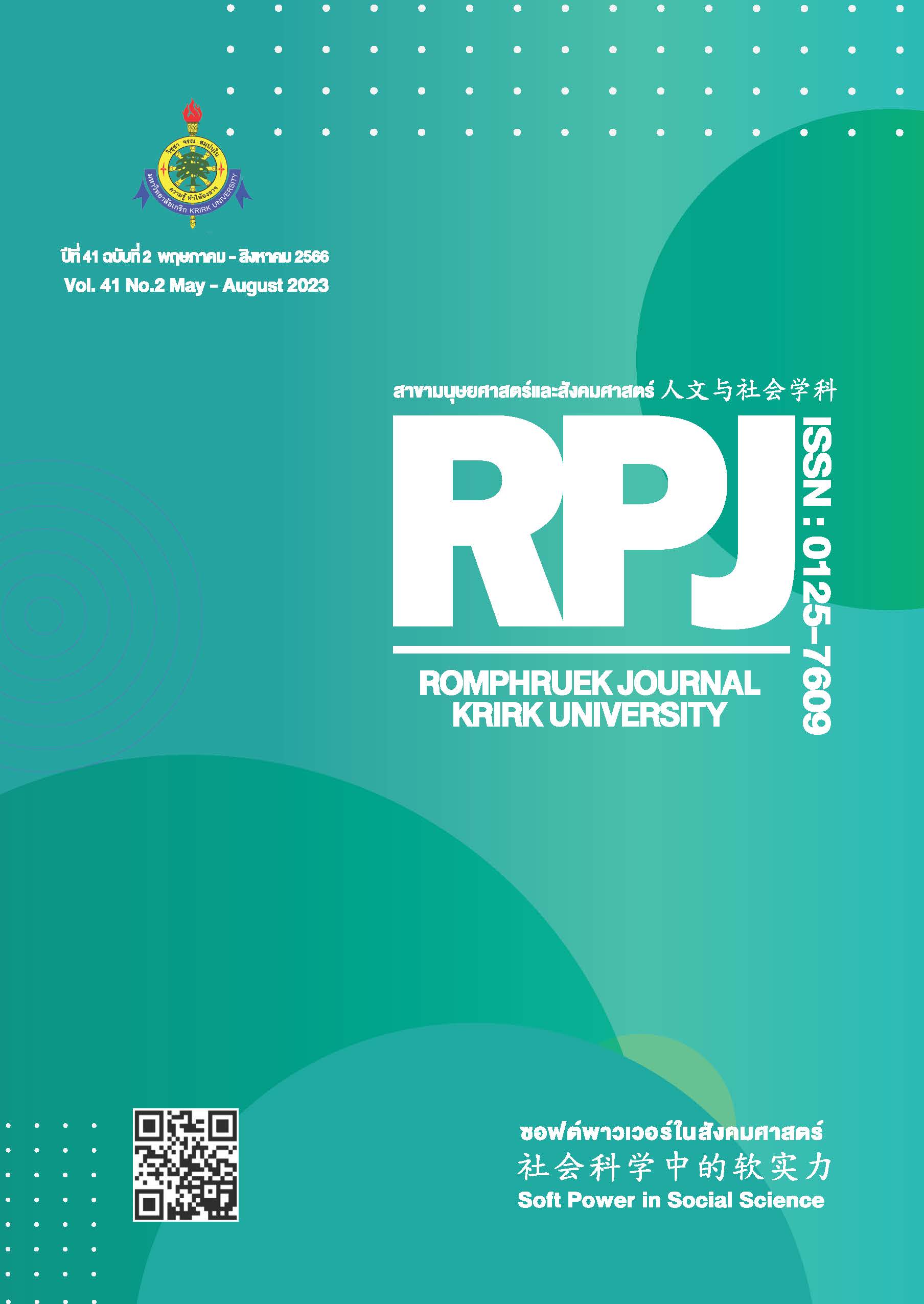Japan’s direction to support character industry and policy recommendations to Thailand through the lens of “Soft Power”
Main Article Content
Abstract
Thailand’s character industry is efficient in creators, production process and had a great potential but if we look at the detail, there are only few types of character that can bring to full potential on marketing and be a well-known character. This article will analyze Japan’s character industry through the lens of Soft Power. As a suggestion for Thailand’s character industry to bring Thailand’s character industry to full potential and be able to create Soft Power for Thailand in the future.
Article Details

This work is licensed under a Creative Commons Attribution-NonCommercial-NoDerivatives 4.0 International License.
Every article published in the Romphruek Journal of the Humanities and Social Sciences is the opinion and point of view of the authors. Thery're not the viewpoint of Krirk University or the editored department. Any part or all of the articles for pablication must be clearly cited.
References
กระทรวงดิจิทัลเพื่อเศรษฐกิจและสังคม. (2561). แผนแม่บทการส่งเสริมเศรษฐกิจดิจิทัล. (2 มีนาคม 2565)สืบค้นจาก https://www.depa.or.th/storage/app/media/file/depa-Promotion-Plan-Book61-65.pdf.
ธัญญารัตน์ โคตรวันทา. (2561). คุมะมง: หมีน่ารักที่ขโมยหัวใจผู้คนด้วยวิธีคิดทางการตลาดแบบญี่ปุ่น. ThePeople. (6 มิถุนายน 2565) สืบค้นจาก https://thepeople.co/kumamon-japan/.
ปัทมา จันทร์เจริญสุข. (2552). การ์ตูนญี่ปุ่น: Soft Power ของนโยบายวัฒนธรรมของประเทศญี่ปุ่น. การประชุมวิชาการ มหาวิทยาลัยเกษตรศาสตร์ วิทยาเขตกำแพงแสน ครั้งที่ 6 วันที่ 8 ธันวาคม 2552, 1487-1497.
วาสนา ปานนวม. (2555). การส่งเสริมการ์ตูนของญี่ปุ่น: เครื่องมือเพิ่ม Soft Power และผลประโยชน์ทางเศรษฐกิจ. วารสารญี่ปุ่นศึกษา, 29(1), 76-85.
วีรยุทธ พจน์เสถียรกุล และจิราพร พรประภา. (2019). ไร้สาระหรือมีแก่นสาร?: คุณค่าของมังงะ (การ์ตูนญี่ปุ่น)ในฐานะผลผลิตทางวัฒนธรรมประชานิยมต่อสังคมไทย. International Journal of East Asian Studies, 23(2), 384-298.
ศุภเจตน์ จันทร์สาส์น. (2560). โครงการ แนวปฏิบัติที่ดีสู่ความสำเร็จในการพัฒนาธุรกิจคาแรกเตอร์ไทย: บทเรียนจากความสำเร็จของธุรกิจคาแรกเตอร์ญี่ปุ่น.คณะเศรษฐศาสตร์และการลงทุนมหาวิทยาลัยกรุงเทพ, กรุงเทพฯ.
สำนักงานส่งเสริมเศรษฐกิจดิจิทัล. (2562). ระบบนิเวศของอุตสาหกรรมดิจิทัลคอนเทนต์ไทย ตอนที่ 3 (สาขา แคแรคเตอร์). (2 มีนาคม 2565) สืบค้นจากhttps://www.depa.or.th/th/article-view/3-digital-content-series-character.
Brand Finance. (2022). Global Soft Power Index 2022. (2 มีนาคม 2565) สืบค้นจาก https://brandirectory-live-public.s3.eu-west-2.amazonaws.com/reports_free/brand- finance-soft-power-index-2022.pdf.
Joseph S. Nye, J. (2004). SOFT POWER:THE MEANS TO SUCCESS IN WORLD POLITICS:PublicAffairsTM.
Joseph S. Nye, J. (2021). Soft Power: the evolution of a concept. Journal of Political Power.(2 มีนาคม 2565) สืบค้นจาก https://doi.org/10.1080/2158379X.2021.1879572.
Ministry of Economy Trade and Industry. (2016). Content Industry: Current Status and Direction of Future Development. (2 มีนาคม 2565). สืบค้นจาก https://www.meti.go.jp/english/policy/mono_info_service/content_industry/pdf/20160329001.pdf.
Portland. (2019). THE SOFT POWER 30: A Global Ranking of Soft Power 2019 Portland. (2 มีนาคม 2565) สืบค้นจาก https://softpower30.com/.
Umparin Boonsinsuk. (2019). Character Licensing and Digital Path to Monetization, Case Studies from Thai Creators. Executive Journal, 39(1), 12-23.


